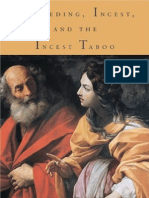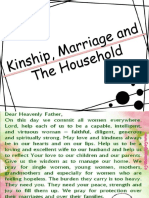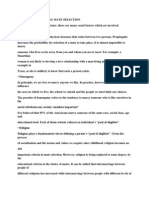0 ratings0% found this document useful (0 votes)
3 viewsMarriage & Family
Marriage & Family
Uploaded by
Muneeb R. KambohCopyright:
© All Rights Reserved
Available Formats
Download as PPT, PDF, TXT or read online from Scribd
Marriage & Family
Marriage & Family
Uploaded by
Muneeb R. Kamboh0 ratings0% found this document useful (0 votes)
3 views37 pagesCopyright
© © All Rights Reserved
Available Formats
PPT, PDF, TXT or read online from Scribd
Share this document
Did you find this document useful?
Is this content inappropriate?
Copyright:
© All Rights Reserved
Available Formats
Download as PPT, PDF, TXT or read online from Scribd
Download as ppt, pdf, or txt
0 ratings0% found this document useful (0 votes)
3 views37 pagesMarriage & Family
Marriage & Family
Uploaded by
Muneeb R. KambohCopyright:
© All Rights Reserved
Available Formats
Download as PPT, PDF, TXT or read online from Scribd
Download as ppt, pdf, or txt
You are on page 1of 37
Marriage and the Family
What We Will Learn
• Is the family found in all cultures?
• What functions do family and marriage
systems perform?
• Why do all societies have incest
taboos?
• What economic considerations are
associated with marriage in the world’s
contemporary societies?
Definition of Family
• Social unit characterized by:
• economic cooperation
• management of reproduction
• child rearing
• common residence.
• a male and female adult who maintain
a socially approved sexual relationship
Marriage Defined
• Customs formalizing the relationship
between male and female adults within
the family.
• Regulates the sexual and economic rights
and obligations between a married couple.
• Usually involves an explicit contract or
understanding and is entered into with the
assumption that it will be permanent.
Same Sex Marriage
• The legality of same
sex marriage remains
a contentious issue in
the United States.
Social Functions of Marriage
• Creates relationships between men and
women that regulate mating and
reproduction.
• Provides a mechanism for regulating the
sexual division of labor.
• Creates a set of family relationships that
provides for the material, educational, and
emotional needs of children.
The Family
• The family, such as this one in Japan, provides
a structured environment that supports and
meets the needs of children.
Incest Taboos: Theories
• Natural Aversion - there is a natural
aversion to sexual intercourse among
those who have grown up together.
• Inbreeding - mating between close kin
produces a higher incidence of genetic
defects.
Incest Taboos: Theories
• Family Disruption– mating between
family members would create intense
jealousies.
• Expanding Social Alliances - marrying
outside the family creates a wider network
of interfamily alliances.
Restrictions on Marriage
Partners
Cultures restrict choice of marriage partners
through:
• Exogamy
• Endogamy
• Arranged marriages
• Preferential cousin marriage
• Levirate and sororate
Restrictions on Marriage
Partners
• Exogamy
• A rule requiring marriage outside of
one’s own social or kinship group.
• Endogamy
• A rule requiring marriage within a
specified social or kinship group.
Marrying Cousins
• Charles Darwin
(1809–1882), the
author of Origin of
Species, had ten
children with his wife,
who was also his first
cousin.
Interracial Marriage
• At one time in the United
States, interracial
marriage was against the
law.
• Although these laws no
longer exist, the majority
of Blacks and Whites in
the United States
continue to practice racial
endogamy.
Arranged Marriage
• Any marriage in which the selection of the
spouse is outside the control of the bride
and groom.
Preferential Cousin Marriage
• A preferred form of marriage between
either parallel or cross cousins.
• Cross cousins
• Children of one’s mother’s brother or
father’s sister.
• Parallel cousins
• Children of one’s mother’s sister or
father’s brother.
Levirate and Sororate
• Levirate
• The practice of a man marrying the
widow of a deceased brother.
• Sororate
• The practice of a woman marrying the
husband of her deceased sister.
Number of Spouses
Marriage of one man to one
Monogamy
woman.
Marriage of a man to two or
Polygyny
more women.
Marriage of a woman to two or
Polyandry
more men.
Polygyny
• A man from the
Rashaida Tribe in
Eritrea travels by
camel while his three
wives walk.
Polygyny
• Tom Green, a 21st century polygynist from
Utah, posing with his five wives and some of his
twenty-nine children.
Marriage: Transfer of Rights
• Marriage often includes the transfer of
certain rights between the marrying
parties:
• Rights of sexual access.
• Legal rights to children.
• Rights of spouses to each other’s
economic goods and services.
Economic Transactions of
Marriage
• Bridewealth
• Bride service
• Dowry
• Reciprocal exchange
Bridewealth
• Compensation given upon marriage by the
family of the groom to the family of the bride.
• Approximately 46% of all societies give
substantial bridewealth payment as part of the
marriage process.
• Bridewealth is most widely found in Africa,
where it is estimated that 82% of societies
require the payment of bridewealth.
Marriage Transactions
• Among the Maasai of Kenya and Tanzania,
cows are used as the medium of exchange in
marriage transactions.
Bride Service
• Men give labor to the bride’s family in
exchange for a wife.
• He often moves in with his bride’s family,
works or hunts for them, and serves a
probationary period of several weeks to
several years.
• Found in approximately 14% of societies.
Dowry
• Transfer of goods or money from bride’s
family to the groom or the groom’s family.
• Practiced in less than 3% of societies.
• If the marriage ended in divorce, the
woman was entitled to take the dowry
with her.
Dowry
• Family members of a
Kazakh bride-to-be
carry her dowry on
camels in Xinjiang,
China.
Reciprocal Exchange
• Involves the roughly equal exchange of
gifts between the families of both the
bride and the groom.
• Found in approximately 6% of the
societies listed in Murdock’s Ethnographic
Atlas, most prominently in the Pacific
region and among traditional Native
Americans.
Divorce
• Like approximately
half of all marriages
in the United States,
the marriage of Brad
Pitt and Jennifer
Aniston ended in
divorce.
Divorce Across Cultures
• Divorce arrangements found in the many
cultures of the world vary widely.
• Organizations such as the Roman
Catholic Church prohibit divorce
outright.
• A Hopi woman from Arizona could
divorce her husband easily by simply
putting his belongings outside the door.
Divorce Rates in the United
States, 1950 to 2000
Divorce Rate/1000
Year
Population
1950 2.6
1960 2.2
1970 3.5
1980 5.2
1990 4.7
2000 4.2
Factors in the Rising U.S.
Divorce Rate
• Industrialization and urbanization have
undermined traditional functions of the family.
• Less time spent with family members and less
willingness to make sacrifices for the good of
the family.
• Western culture emphasizes romantic love as
the basis for marriage.
• Less stigma attached to divorce than in the
past.
Marriage Residence Patterns
• Patrilocal (69%)
• Couple lives with or near relatives of
the husband’s father.
• Matrilocal (13%)
• Couple lives with or near the relatives
of the wife.
Marriage Residence Patterns
• Avunculocal (4%)
• Couple lives with or near the husband’s
mother’s brother.
• Ambilocal (9%)
• Couple has a choice of living with relatives of
the wife or the husband.
• Neolocal (5%)
• Couple forms independent residence away
from relatives.
Family Structures
• Nuclear family – Comprises wife,
husband, and children
• Extended family – A larger social unit,
comprising relatives from three or more
generations.
Nuclear Family
• What type of
residence pattern is
followed by this North
American nuclear
family?
Extended Family
• An extended family gathering in Henan
Province, China.
Marital Status of U.S.
Population: 1980 –1999
1980 1990 1995 1999
Never
20.3 22.2 22.9 23.9
Married
59.5
Married 65.5 61.9 60.9
6.7
Widowed 8.0 7.6 7.0
9.9
Divorced 6.2 8.3 9.2
You might also like
- Taboo ThesisDocument8 pagesTaboo ThesisClaudia Acosta100% (2)
- Kinship Marriage and The HouseholdDocument46 pagesKinship Marriage and The HouseholdPhilip Espiritu Cayaban100% (1)
- Incest 5Document239 pagesIncest 5Dana Simireanu Dana33% (9)
- Marriage: An Anthropological PerspectiveDocument21 pagesMarriage: An Anthropological PerspectiveKalai VananNo ratings yet
- Kinship Marriage and HouseholdDocument26 pagesKinship Marriage and Householdgandaku2No ratings yet
- 16 Ucsp Kinship, Marriage and The HouseholdDocument32 pages16 Ucsp Kinship, Marriage and The HouseholdLovejean MalapoNo ratings yet
- Soc. 111 PDFDocument93 pagesSoc. 111 PDFmojeedsodiq0No ratings yet
- GS 355 Unit-4Document34 pagesGS 355 Unit-4nawaf--0No ratings yet
- UntitledDocument21 pagesUntitledXuezhou Liu (Jeremy)No ratings yet
- Family Law LWFL121 Chapter 1Document31 pagesFamily Law LWFL121 Chapter 1lara11vanessaNo ratings yet
- 16 Ucsp Kinship, Marriage and The HouseholdDocument35 pages16 Ucsp Kinship, Marriage and The HouseholdTheDefender DotcomNo ratings yet
- Marriage and FamilyDocument29 pagesMarriage and Familyowale-karigidi.2303916No ratings yet
- Marriage, Family, KinshipDocument50 pagesMarriage, Family, Kinshipcashielle arellanoNo ratings yet
- Kinship by Blood and MarriageDocument12 pagesKinship by Blood and MarriageHannah Aquino75% (4)
- Family and Marriage: Week 9 by DR Nadeem Omar TararDocument14 pagesFamily and Marriage: Week 9 by DR Nadeem Omar Tararjgfjhf arwtrNo ratings yet
- Family & Marriage: Course Code: SOC101 Course Teacher: Farhana Sultana (FNS)Document49 pagesFamily & Marriage: Course Code: SOC101 Course Teacher: Farhana Sultana (FNS)Renjumul MofidNo ratings yet
- Q2 - 06 - Kinship, Marriage and HouseholdDocument37 pagesQ2 - 06 - Kinship, Marriage and HouseholdHenry BuemioNo ratings yet
- Kinshipmarriageandthehousehold 170907030015Document35 pagesKinshipmarriageandthehousehold 170907030015Monria FernandoNo ratings yet
- Chapter 3 EngDocument7 pagesChapter 3 EngITZHAZOT GAMINGNo ratings yet
- ANT207 - Lecture 5Document4 pagesANT207 - Lecture 5Michael Anthony TsirakisNo ratings yet
- Marriage and Family LifeDocument49 pagesMarriage and Family LifeSunny SkNo ratings yet
- Family:: Kinship, Marriage, and The HouseholdDocument21 pagesFamily:: Kinship, Marriage, and The HouseholdmineNo ratings yet
- Marriage PresentationDocument12 pagesMarriage Presentationapi-259712547100% (1)
- How SocietyDocument16 pagesHow SocietyNicoleAdrienneRiveraNo ratings yet
- Chapter 1 - Meaning of Marriage FamilyDocument57 pagesChapter 1 - Meaning of Marriage FamilyBenjhon S. ElarcosaNo ratings yet
- Family: Ma'am Asma AsadDocument68 pagesFamily: Ma'am Asma AsadsanaNo ratings yet
- CH 9Document36 pagesCH 9Malik ImranNo ratings yet
- KinshipDocument34 pagesKinshipRowjan SantosNo ratings yet
- KinshipDocument45 pagesKinshipRuby Lorenz DaypuyartNo ratings yet
- Families Kinship and DescentDocument42 pagesFamilies Kinship and DescentAnn Marie Palahang100% (1)
- Kinshipmarriageandthehousehold 170907030015Document35 pagesKinshipmarriageandthehousehold 170907030015Ronalyn CajudoNo ratings yet
- Modern US FamilyDocument9 pagesModern US FamilyDaryna KharukNo ratings yet
- Lesson 5 - Kinship, Marriage, and The HouseholdsDocument23 pagesLesson 5 - Kinship, Marriage, and The Householdsmescobin.fsgincNo ratings yet
- Marriage and Family in Pre-ColonialDocument36 pagesMarriage and Family in Pre-Colonialomotosooreoluwa5No ratings yet
- Marriage - Definition, Its Type and CharecteristicsDocument13 pagesMarriage - Definition, Its Type and Charecteristicsfrankie cemaniaNo ratings yet
- ANTH 152 Week 8 Lecture BDocument24 pagesANTH 152 Week 8 Lecture Bmalakalsaleh05No ratings yet
- Marriage, Family and Domestic GroupsDocument44 pagesMarriage, Family and Domestic GroupsMohd Suhaidi SallehNo ratings yet
- UCSP Week 8 - KINSHIP, MARRIAGE, AND THE HOUSEHOLDDocument11 pagesUCSP Week 8 - KINSHIP, MARRIAGE, AND THE HOUSEHOLDSam Gutierrez100% (1)
- Nota Ringkas AA20303 Sistem KekeluargaanDocument33 pagesNota Ringkas AA20303 Sistem KekeluargaanDessyEchi67% (6)
- Kinship, Marriage, and The HouseholdDocument31 pagesKinship, Marriage, and The HouseholdJestoni AmbrocioNo ratings yet
- Kinship by MarriageDocument11 pagesKinship by MarriageSanNo ratings yet
- Marriage & Family: I Family As InstitutionDocument5 pagesMarriage & Family: I Family As InstitutionShelly BhattacharyaNo ratings yet
- UCSPDocument19 pagesUCSPVirgilNo ratings yet
- Changing AttitudesDocument11 pagesChanging AttitudesTimmons GwenNo ratings yet
- S11UCSPDocument4 pagesS11UCSPbtobmelody098No ratings yet
- Family and EducationDocument19 pagesFamily and Educationsomintacshane792No ratings yet
- Module 6 KinshipDocument39 pagesModule 6 Kinshipjhenerbong.nonesaNo ratings yet
- UNIT FOUR Family and Intimate RelationshipsDocument49 pagesUNIT FOUR Family and Intimate RelationshipsjamelagivenessNo ratings yet
- Madhu Socio PDFDocument35 pagesMadhu Socio PDFmaddy bhujelNo ratings yet
- Family PowerpointDocument25 pagesFamily PowerpointBon Carlo Medina MelocotonNo ratings yet
- FamilyDocument9 pagesFamilytoryzhukNo ratings yet
- KinshipDocument25 pagesKinshipThe Green CrewNo ratings yet
- Cultural - Social - Political InstitutionsDocument4 pagesCultural - Social - Political InstitutionsRobin Suarez ViladoNo ratings yet
- CH 15Document51 pagesCH 15Sai CharanNo ratings yet
- Interracial MarriageDocument18 pagesInterracial Marriageapi-259934658100% (1)
- Families, Kinship, and DescentDocument20 pagesFamilies, Kinship, and DescentRose MaryNo ratings yet
- Chapter 4 Lesson 2Document15 pagesChapter 4 Lesson 2Eleazar Frias BarroNo ratings yet
- Family: Mrs - Neethu Vincent Asst Professor KVM College of NursingDocument14 pagesFamily: Mrs - Neethu Vincent Asst Professor KVM College of NursingNeethu VincentNo ratings yet
- Family: Mrs - Neethu Vincent Asst Professor KVM College of NursingDocument14 pagesFamily: Mrs - Neethu Vincent Asst Professor KVM College of NursingNeethu VincentNo ratings yet
- Family and MarrigeDocument4 pagesFamily and MarrigeSong Sorphea100% (1)
- 66210d64272fd70018780eb0 - ## - Compilation Notes - 3 PDF OnlyDocument45 pages66210d64272fd70018780eb0 - ## - Compilation Notes - 3 PDF OnlychaitalidevmaneNo ratings yet
- QUESTION: How Are Elements of Biology and Culture Possibly Synthesized and Reflected in Kinship? Provide IllustrationsDocument3 pagesQUESTION: How Are Elements of Biology and Culture Possibly Synthesized and Reflected in Kinship? Provide IllustrationsShagun MittalNo ratings yet
- Alliance Theory SummaryDocument5 pagesAlliance Theory SummaryAnusha WaniNo ratings yet
- AnthropologyDocument99 pagesAnthropologySelam Andemichael100% (2)
- Marriage, Family, KinshipDocument50 pagesMarriage, Family, Kinshipcashielle arellanoNo ratings yet
- Oedipus Wrecked. The Moral Boundaries of IncestDocument20 pagesOedipus Wrecked. The Moral Boundaries of Incestbirrafria100% (2)
- Chapter ThreeDocument12 pagesChapter ThreeMiliyonNo ratings yet
- Kinship 1 (New Ed.)Document11 pagesKinship 1 (New Ed.)shilpiNo ratings yet
- Factors Influencing Mate SelectionDocument3 pagesFactors Influencing Mate SelectionbabeNo ratings yet
- Family & Marriage: Course Code: SOC101 Course Teacher: Farhana Sultana (FNS)Document49 pagesFamily & Marriage: Course Code: SOC101 Course Teacher: Farhana Sultana (FNS)Renjumul MofidNo ratings yet
- Incest and Identity: A Tique and Theory The Subject AND Ncest Prohibit ONDocument13 pagesIncest and Identity: A Tique and Theory The Subject AND Ncest Prohibit ONorakles100% (1)
- Georges Bataille - The Accursed Share Vols II and IIIDocument231 pagesGeorges Bataille - The Accursed Share Vols II and IIIpash6867% (3)
- Perkahwinan Dan KeluargaDocument65 pagesPerkahwinan Dan KeluargaHambali RamleeNo ratings yet
- A Refinement of The Concept of Household - Donald BenderDocument13 pagesA Refinement of The Concept of Household - Donald BenderolivandiNo ratings yet
- Anthropology Power PointDocument135 pagesAnthropology Power PointTesfalem Legese100% (1)
- Lecture 3 Kinship2Document17 pagesLecture 3 Kinship2Grace MguniNo ratings yet
- Marriage, Family and Domestic GroupsDocument44 pagesMarriage, Family and Domestic GroupsMohd Suhaidi SallehNo ratings yet
- Anthropology Chapter 2Document31 pagesAnthropology Chapter 2Meron EshetuNo ratings yet
- Womans Evolution From Matriarchal Clan To Patriarchal Family - Evelyn ReedDocument512 pagesWomans Evolution From Matriarchal Clan To Patriarchal Family - Evelyn ReedKaveh AhangarzadehNo ratings yet
- Day 3 MarriageDocument40 pagesDay 3 Marriagediwakarj7_310135942No ratings yet
- KINSHIP TERMS + Iravati KarveDocument9 pagesKINSHIP TERMS + Iravati KarveMelissa SmithNo ratings yet
- Anthropology PPT AllDocument94 pagesAnthropology PPT AllAidanNo ratings yet
- Social Anth. Summary - NoteDocument18 pagesSocial Anth. Summary - NoteGizachew NadewNo ratings yet
- Anthropology 1012, Unit 3,4,5Document163 pagesAnthropology 1012, Unit 3,4,5Abdulmejd Kelil Shifa (Techkelster)No ratings yet
- Marriage (Handout 12) NADocument18 pagesMarriage (Handout 12) NAtubai processNo ratings yet
- The Incest Taboo, Exogamy and EndogamyDocument2 pagesThe Incest Taboo, Exogamy and EndogamyDarry BlanciaNo ratings yet
- Unit 2 Paper 1Document201 pagesUnit 2 Paper 1suraj Nimbalkar100% (1)





















































































